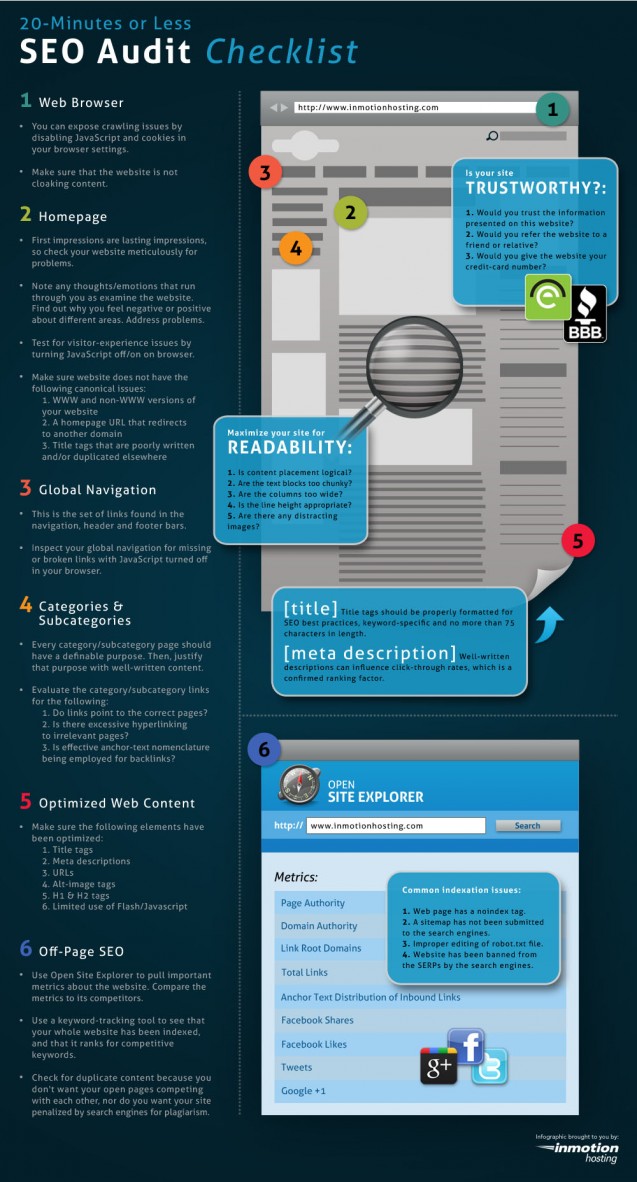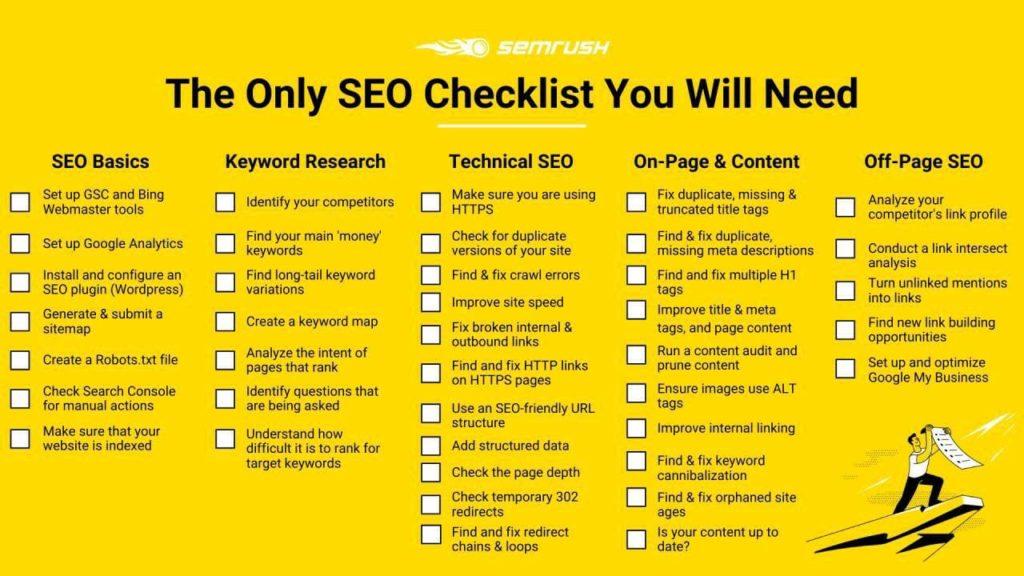Site Audit – What or Why?

A website audit or Website SEO Audit is the foremost step to start a successful SEO campaign. A proper website audit will tell us on which areas the website is falling short with respect to SEO. And many of us skip this step thinking this analysis may take time and proceed with the conventional steps for the SEO which should not be the case because it is the website audit which will tell us on which areas the website is missing out.
Hence a website audit is a must to start off with any website makeover. Here are the steps which one should follow for a quick website audit. Mostly it’s recommended that you first do a manual website audit as described below and then you can use the various website audit tools to do a site audit in just 30 seconds to 1 minute. Many tools are there we have already mentioned at the bottom of this page.
How to do a quick technical SEO audit for a website
Related post: How To Do A BackLink Audit For Your Website? & Some Useful Link Auditing Tips
Power Tips To Do SEO Audit Or Website Audit Effectively
Check the tags
The title tag should be present for every page and it should be unique so that it can let the search engines know what the respective page is about. It should be within 70 characters including spaces. The meta tag or meta description describes the page briefly for the target audience and it should be within 150-165 characters including spaces as the search engines probably display the first 140-150 characters. Then check for <h1>tag or h1 heading as each page should have one <h1>tag.
H1 heading should be an important phrase or line on webpage telling the search engines more about the webpage. And the last tag to look in is the image description also known as the alt text. All the images should have alt text or image description as that would help the search engine read the images. Finally the most important point here is all the tags i.e., title tag, meta tag, <h1> tag and image description should have the targeted keyword.
WWW Resolve
We have to make sure that websites with or without www should direct to one URL otherwise the search engine will see it as a duplicate website having duplicate content which is not good for SEO. Similarly the website IP should direct to the website’s domain name to avoid duplicity.
Check for robots.txt
Robots.txt should be present for every website. Robots.txt files allows us to restrict the desired section from the search engine robots. Preferably we should not restrict any specific area and let the robots crawl the entire website which is good for SEO.
Check for Site Map
A sitemap is very essential for the search engine robots to index the pages of the website. A sitemap consists of URLs which are available in the website and it helps robots to crawl the website in a proper manner. So a XML sitemap should be present.
Check for flash and frames
Flash is not SEO friendly because search engine robots can’t crawl the sites with flash. Same goes for the frames as search engine robots can’t crawl or index the content with in them. It is always recommended that the flash sites should be reconfigured to HTML.
Check for domain registration
Age of domain is very important factor for the Google search engine. The older the website is or if the website’s domain is registered in advance for 5-6 years , the more value the website gets from Google, though there are many other parameters but it’s a signal too. It is recommended that we register a domain for longer period.
Check for 404 error page
A custom 404 error page should be present for every website.
Check for page load time
A higher page load time will drive away the visitors. So it is always preferred to use coding which will make the website run faster. A website load time should be lesser than 5 seconds. Check for using less external Javascript or inline CSS. Use CSS sprites and define image height & width. Also use gzip or caching plugins.
Check for Dublin Core
Dublin Core is a set of standard metadata elements used to describe resources for the purpose of the discovery. Website should take advantage of Dublin Core for describing its own website’s content. We should provide the details of the website in http://geo-tag.de/generator/en.html and then put the generated code before closing the header part of HTML.
Check for microformats
A microformat is a technical semantic markup that can be used to structure the data submitted to search engines in a better way. So Microformats should be present for every website.
Check for url format
For SEO, a website should have a clean URL so that it can be easily understood. It should be descriptive without any jargons as descriptive URL is better recognized by search engines. A user should be able to look at the address bar and make an accurate guess about the content of the page before reaching it.
Keyword and its consistency
Before we start with the SEO we should do a research on the keywords of the respective page because based on the targeted keywords we have to make the changes. The targeted keyword should be consistent in title, meta description, H1 heading, image description, content, internal links anchor text and backlinks anchor text.
Content length and blog
Search Engines love content. We need to see whether the website is having quality content or not. It is recommended that each webpage should have at least 750-2000 words consisting the targeted keywords. Long form of content of more than 5000 words is recommended with table of content. A Regular update of content is appreciated by the search engine robots and hence starting up blog is a great idea to boost SEO as the content is updated on regular basis in blog.
Text/html ratio
Text/HTML ratio should be more than 15%. Hence if there is fair enough content in the website the search engines will rate the website good.
Check for the link structure
There should be no broken links in the website as that has negative impact on SEO. We should also check whether there is fair number of backlinks or not. Even the internal linking structure should be good.
Check for social signals
Social signals are important to check how your site is popular on top social media sites. The more engagement and share your site has, the better the SEO. Also your site must have schema.org structure and Facebook opengraph protocol.
Check for Responsive design
Check your site is mobile responsive or not. If your site has a meta view port tag, it’s better for SEO
Check for W3C validation
Though it is not directly related to SEO, but the less error you have, it’s the better. A clean code is always good.
Check for overall Site structure
Check for overall site structure, page level structure, page hierarchy, keyword cannibalism, content structure.
Check for strategic business representation, Competitors & Feature analysis
Check with competitors what features and business strategy they are using for digital marketing. Plan accordingly. Check for website’s call of action & design issues.
Check Google Analytics & Google webmaster central data
Get insights from Google analytics & Google webmaster central and take decisive action items.
Check website heatmap
Check website heatmap to know which sections are getting more attention and try to place the most important elements there.
Useful Website Audit Tools, SEO Audit Tools
- Seven Boats Website Audit Tool
- UberSuggest Tool
- Woorank
- Alexa
- Backlinkwatch
- Mozbar,
- SEOMoz Site explorer,
- Spyfu,
- SEMRush,
- Traffic Travis,
- Linkdex,
- Google analytics,
- Google webmaster central
- SEO tools from Seven Boats
- Free SEO Tools
- Nibbler.Silktide
- RankWatch
- iWebChk.com
- SEOptimer
- Web Developer Toolbar
- User Agent Add-on
- Firebug
- Link Checker
- SEObook Toolbar
- SEOmoz Toolbar
- Xenu
- Screaming Frog
- Your own scraper
After checking the above points, we will get an idea of the part or component the website is lacking and hence we can work accordingly to improve the performance of the website. For in depth website analysis contact us.
Site Audit – A Rough Sketch Of the Website
A proper site audit points out the loopholes that need to be fixed/ modified to attract more more visitors to the site. Here is a guide to site audit.

“Know your website’s health”. It is very important to get the updates of how your website is performing on the Google search engine rankings. There are various reasons for which visitors may feel that your site is not being adequately informative or attractive, which ultimately drives out the visitors from your site.
A proper site audit points out these loopholes that need to be fixed/ modified to attract more & more visitors to the site. Previously, it was a bit challenging to get a proper site audit done. But nowadays with so many tools available, it is becoming easier for common people to get a rough idea of their website’s performance.
Let us break the topic of analysis & try to treat them individually in the light of SEO :
Content Audit :
One of the most important aspects of your website’s performance is the content strategy & placing them accordingly in each of the web pages.
Meta Title –
for homepage, one should emphasis on the most related keyword of your business, preferably with the location. Ideally a meta title should be within 70 characters.
Meta Description –
Do not stuff your description with the keywords, rather give a brief write up using your keywords, so that one can understand the flow being normal & simple. Meta description should not exceed 160 characters.
Heading –
Use relevant H1,H2,H3 for every web pages. There should be only one H1 in every web page.
Image –
Provide alt attribute to each of your images, alt attribute simply can be the most fitted keywords that relate to the concerned image.
Technical Audit :
Make sure that your website is resolved from all technical grounds. Your website should possess the following major attributes :
www resolve –
your website without www should also redirect to the same domain
robots.txt –
make User-agent: *
Disallow:
Xml sitemap –
using a related tool that generates the code for your xml sitemap, just add the code to the root domain.
301 redirect –
set any 1 of your webpage as the default page for 301 redirect or 404 redirect.
Text-html ratio –
analyses whether your website is unnecessarily overstuffed with codes or not.
Linking :
A strong configuration on both internal and external linking is required for a better website. The strong internal linking enables the Google spider to crawl each of the pages. It is not advised to keep a single page isolated from crawling.
External linking proves how popular your website is. It is very important to link your website with the other related quality websites or sites with high domain authority. External link building is a continuous process that yields effective results in the long run.
Site audit is a routine check up of your website’s health. It does not point out the weaknesses of your website, but it suggests on the modifications that are required for the overall performance of your website.
Related Reading: Top 5 On-Page SEO Tricks That Work
Do You Audit your Web Content?
It is an obsolete thought to look upon the word audit only fit for number crunching and hardcore business statistics. Audits can be carried out for your content as well. Just like in an audit conducted on your business ledgers, the idea of the content audit is to figure out how much you have achieved by writing a particular blog post or web page.
There are so many metrics available online that can tell you the reach and impact of your content if you have the heart to follow those road-maps. In this post, we will take a closer look at how to audit your web content.
To begin with, take stock of all the web content that you are publishing, starting now. Keep track of the articles being published on online submission sites, blog posts being put up in your own blog or as guest posts on other blogs and also additional web pages that you are adding to your existing number on the website.
For each web content page that you put out, you need to know how much they have worked, if at all. A quick look at the bounce rates, the page views, the average time spent on each page and several other statistics will tell you if readers actually read your page.
A study of the clicks on anchor texts provided in the content and the number of social media shares are other metrics to measure the success or otherwise of a content page. A content that is shared more on Twitter or Facebook is definitely a bigger success in terms of impact than another article which you think was better written.
You don’t get to judge here, just analyze the available data. Armed with the statistics, you will be in a better position to take a call on what kind of posts work for your business and the topics that you want to cover. Other than these audits, asking people to come up with ideas or vote online about topics that they want to read will keep your content juices flowing.
The content audit will help you in taking the right content marketing decisions. In this age of stiff competition in the content domain, you have to cater to tastes or fade into oblivion.
Importance of SEO Review & Website Audit
Learn the importance of SEO review website audit. Get authentic data and statistics about why you need SEO. Importance of SEO website audit in a nutshell.

It is not enough for SEO teams to put up a website and look after the day to day optimization. For the website and the SEO services to be successful, reviews are absolutely essential. Since the importance of SEO is high enough for business-growth, the website audit should be done on a regular basis.
The purpose of this drill is to locate and remove the problem areas on the web pages. Every website, no matter how much online traffic it is getting, has room for improvement. It is also necessary that the website is updated with fresh content. Online users would not like to visit a website that is rarely touched upon. They want something new each time they visit your website.
Related reading – Get rid of boring blog content, Content writing tips for beginners
Adding fresh material to the website helps SEO efforts. Search engines like to find new content on web pages. When that happens regularly, your SEO services receive a boost automatically. Reviews help to identify the web pages where the content is not doing as it should.
It may be that there is a disconnect between what the page offers and what the online visitors are looking for. In such cases, it will be important to change the SEO perspective or modify the content. Statistical data of the website will be the key to unlock this problem. For this, SEO review or website consultancy is a must.
No SEO effort can work in isolation. You have to take the competition in consideration. Studying what your competitors are doing on the SEO front will help you change tactics or simply inspire you to do something different.
You cannot ignore the new trends that your competitors will bring into the game. At the same time, you have to understand that your SEO needs are different from those of your competitors. During reviews, your SEO team must not blindly follow trends just because your competitors are doing so.
SEO Audit: The Five Questions to Ask

We have written about SEO audit extensively on this blog. We have covered topics that will tell you what the ideal metrics of SEO should be and how to measure value through them. During the course of writing these blog posts and through my work in SEO, I noted that despite knowing the SEO audit tools, most teams fail to make the dividends that they signed up for.
Exploring this anomaly, I found out that the reason is very simple indeed. SEO audit will give you the right value of your brand only when you ask the right questions. It is like asking a fish the depth of a river instead of the height of a tree.
In my meetings with clients and financiers as a digital marketer, I have jotted down some common questions. Like, when do we start making money out this process? A very practical and justified question it is! Because irrespective of the lack of tangible metrics in many aspects, anyone who puts in money would like to know how it is being spent.
Other than this fundamental question, there are others which do the rounds. Like, which are the keywords that you want our brand to rank? This is a question that is best answered by the brand owners themselves because they know better what works for their brand and what doesn’t. It is more so because they hold the vision where they want the brand to go in the coming days.
Keeping these questions, along with several others, I have developed the top five questions that SEO professionals should ask during their audit. Answering these questions will hold the key to an audit that will address all the concerns of the brand owners or clients.
Question 1: What is the USP of our brand?
I have dealt with this topic in many earlier posts here. It is very important that SEO professionals know and understand the USP of a brand before trying to promote or sell it online. No one likes a copy of another. There must be some difference. Even if you are selling a product imitation, there is something that distinguishes it from the parent source. Like price or even better customer service! Blow up this USP in the SEO initiative. And how well you do to promote or sell the USP of your brand should be there in the audit report.
Question 2: Do you address customers’ questions?
Brands, especially those functioning online, are so busy shouting what they want to say that they forget what the customers want to hear. No one wants to know how much effort you take to dish out a particular product or service. Customers want to know what they will benefit from the effort that you put it. Getting the drift? Tune your SEO messages accordingly. The audit report of your SEO team must contain answers to find out how well you have addressed the queries and questions of your customers.
Question 3: What do we show off to the search crawlers?
Your ticket to the SEO world is the search engine and its crawlers. And they are always looking for something different from the websites that they track. Do you have a state-of-the-art mobile friendly version of your website? Or, an app that makes like easier for customers?
Show them off to the search crawlers and earn some brownie points. If you are able to do that or do not have any such show-off-worthy material, it should feature in your audit report. You should get on board asap!
Question 4: Who are your brand ambassadors?
We are not talking about celebrities here! We are talking about that faceless, nameless group of people who speak well of your brand and share your content online. Identify and empower them. In this social media age, they can do for your brand what your hired employees cannot.
They can take your brand’s message to their own personal circles and make it big. Once you identify them, you have to find out why they like and prefer your brand. Give them more of it and you will ensure that you are never short of positive publicity. Of course, pin them up in your audit report!
Question 5: What is the conversion process?
This part is pure business. With SEO, you bring online visitors to your website. How many of these visitors convert into customers? That is a number that was always there in digital marketing audit reports. I propose you include the conversion process as well! I have noted that the cumbersome and even complicated structure of signing up for a brand often repels customers away. Smooth out these worries in your audit report.
Do you have any more questions that you want to ask? Shout it out here!
Things to Analyze Before Initiating Your SEO Campaign
A SEO campaign has certain prerequisites which essentially determine its success. Know the important things to analyze before initiating your SEO campaign..

A SEO campaign has certain prerequisites which essentially determine its success. Your website should look good, provide intuitive navigation and have clear call to actions. The content should be created with the target audience in mind. It should be of high quality to rank in search engines and help in link building.
As every page of the site can be a potential point of entry of visitors, it should be optimized for keywords after conducting keyword research. It is also vital to generate high quality links and make the best use of social media to get the most out of your campaign.
Though it takes time to actually see the results, SEO eventually helps you gain momentum, increases website traffic and improves conversion rates, provided you focus your efforts on your goals. Before you plunge into your SEO campaign, there are certain factors which require in-depth analysis, to help stabilize your online presence. Here are some things to analyze before initiating your SEO campaign:
SEO Market Research
SEO Market research is a crucial aspect of SEO as it helps you learn from the expertise of others. First and foremost, get to know the landscape of your market and determine the level of competition. Find out who the big players are and what they do to establish an edge over others.
Get to know what your clients are looking for. Build a list of keywords for further analysis. Search for the keywords using suitable keyword research tools. This will help you find details of keyword concentration on competitors’ websites. Understand how links have been utilized and study linking patterns to see if you find potential linking opportunities for the content on your site.
Benchmarking Analysis
Start with an analysis of your site. Analyze where you stand, where you would like to be and what’s stopping you from making the desired level of progress. Benchmark your site’s performance against your competition.
Track your competitors’ links, find out who is linking to them and measure the traffic they receive for targeted keywords. Evaluate your competitors’ strategies and decide on what you can do to gain a competitive advantage. Come up with a plan to enhance your practices and performance and beat your competition.
Competitor Analysis
Pay close attention to the performance, practices and strategies of your competitors. Find out about the number of pages on their respective sites, the age of the domains, the hosting environment, the structure of the sites, their distribution of internal links, the number of inbound links and the anchor text in the links, their social media engagement tactics, details of user engagement and traffic, search volume of keywords etc., to gauge the level of competition.
Pre-SEO Analysis of Website
Before you commence the actual SEO work, a pre-SEO analysis of your website is required to get a clear picture of the site’s current status from the SEO point of view. This acts as a yardstick to measure the results post-SEO. It also helps you get familiar with the site’s overall metrics and trends, informs you about the popularity of links, creates awareness about the ranking of keywords used and lets you know how keyword ranking can be improved.
Be aware of potential problems which may crop up after your site has been optimized for search engines and take the necessary steps to fix the same.
These points will help you compete and get the most coveted top positions in SERPs. Kick-start your SEO campaign now with confidence!
The Daily SEO Checklist for your Website
SEO is not something that follows the popular ad catch-line, fit it and forget it! You have to work daily with a SEO checklist in hand.

Readers of this blog would know that SEO is not something that follows the popular ad catch-line, fit it and forget it! You have to work daily with a SEO checklist in hand. There are no quick fixes to optimizing your website, true.
But it is equally true that there is no auto-run mode for SEO. It cannot work in the model that you achieve some lofty goals in terms of keywords or market dominance and then rest on your laurels forever!
SEO, like the topsoil, will erode away with time unless you work daily to retain it. That is something that I have found that many brands or companies fail to comprehend. They want to get the SEO job done and dusted. They do not realize that it is only the start of the process.
SEO Checklist – Project-based Tasks
In this post, we are looking at some tasks that SEO teams have to do daily in order to keep their stranglehold on the search engine ranks. For example, if you are working on a project that is off the ground and giving you satisfactory results, what do you do next?
You conduct audits on a daily basis. Check for broken links, missed opportunities, untapped potential and other details that slipped under the radar when you launched the project. Daily audits will bring these to light. Fix them up and continue to do that regularly. Once you fix one loose end, check for results. Is it working according to plan? Test and change things around if needed.
SEO Checklist -Goal-based Tasks
I have noticed that defining goals for a SEO team is very important for its success. Otherwise, the team gets caught in the maze with too many options. For a SEO team that works daily, goal-based tasks become important.
Here are some steps that comprise the goal-based tasks of a SEO unit:
- Draw up the broader digital marketing goals of the brand or the company. Next, pencil out the role that you expect the SEO unit to play. Clearly demarcated roles often become the key to success.
- Identify areas and concerns that the SEO team is best suited to address or resolve. For example, in the department of capturing search results through keywords, SEO is the best choice. However, for branding across consumer groups, social media marketing may be more up your alley than SEO. Figure it out with your SEO team.
- Evaluate and test the results again. Just as in project-based tasks, evaluating and then testing again is useful in goal-based work as well. You have to prioritize your tasks and then implement them accordingly.
SEO Checklist – Do the New
You need some additions to the already running SEO machinery. That will definitely come into the picture when you are conducting daily SEO. You might feel that you need a new blog section or a YouTube channel to suit your user engagement. What happens if you do not think about these aspects on a daily basis? You miss out on opportunities even if you have a strong brand presence.
You never know when that will start to slip away. Keep adding to your repertoire. Build up community discussions, provide Yahoo! Answers or even do some social media profiling of your consumer base. That will help you develop a better reach with the options available at your disposal. You have to give yourself the best chance in order to improve your SEO status.
There is the other option of doing something different to grab new and fresh eyeballs. With the same keywords and marketing, you tend to go around in circles with a glass ceiling to rein you in. How about changing track to get new people on board? You can try out some new keywords pulled up from a different perspective.
You can do some brainstorming sessions with your team to find out which other consumer group will find your product or service attractive. It pays to think laterally. Without a daily stab at SEO, you cannot touch these areas of improvement.
The Final Word
Anyone who has worked in the SEO field for some time knows that SEO is not a one-day job. You need to keep working at it continuously to achieve results. I take that discussion a step further: to continue to achieve results or even maintain status quo, you need a daily SEO plan. You need more than just checking Google Analytics or putting up a blog post. You need a plan.
What do you do for your SEO on a daily basis? Pool in your thoughts here!
Another Handy SEO Checklist
Get a handy SEO checklist for search engine optimization of your website. When you decide to revamp your website, apart from ‘Look and feel’ SEO is the most crucial part.
Often, when companies choose to tackle an internet site redesign, these people do not think about natural as an important a part of the overhaul procedure. Sure, your new website might appear attractive — and looks are a crucial “quality signal” within the post-Panda era- but it is also got to possess SEO mojo to carry out and outrank your competition.
Suggestions to make Search engine optimization to your web site overhaul.
Conversion/Sales Objectives
Do you know the primary conversion objectives for that website? Online buy? Phone call? Newsletter sign-up? Ensure that the paths to those are the very first stuff that draws the eye. It is also a part of SEO
Related reading – SEO with conversion optimization
Title Tags and Meta Description Tags
Add distinctive title and meta description tags to the home web page and each web page of the website; incorporate a call to action, advantage statement as well as key phrases within the tags.
Content material
Include a minimum of 750 words, or even ideally 2000-4000 words, of distinctive copy around the home web page and each web page from the website. Add 1 label to get a heading and a minimum of two tags for sub-headlines on the home page and each web page from the website.
Consist of key phrases in all h2 tags. Add links upon key phrases to internal WebPages inside the physique content. In the finish of articles and blog posts, consist of links to associated URLs to encourage individuals to remain in your website longer.
Related reading – Use of keywords in web content heading
Navigation
Consist of key phrases in navigation links whenever possible. Use Html code text or CSS for crawlable/indexable links; avoid Ajax and Flash navigation. Consist of breadcrumb links near the top of the page to show the path to the web page. Consist of a website chart web page inside the footer of each web page.
Usability
Place essential textual content and page components above the fold (inside the first screen duration); research have shown that customers often don’t scroll lengthy pages. Does the brand new website possess the “stickiness” element to make guests wish to remain some time? A decreased bounce rate, along with elevated web page views can help your website within the post-Panda era.
Check our Usability analysis service
Web addresses
It’s greatest not to alter the URLs when the website is established and ranking well. If Web addresses should be modified – or if some present URLs are not however indexed and so you have chose to optimize those URLs — make sure to add 301 redirects towards the new URLs. Make the most of the chance to add key phrases to new URLs, too.
Code and Images
Streamline the code so the search engine spiders will find and concentrate around the essential info (hint: use CSS and maintain it and any JavaScript in external documents). If using Google Statistics makes sure the tracking code continues to be in place during any improvements. Consist of SEO ALT tags along with key phrases upon all images. Use pictures sparingly and optimize them for quicker load time; web page speed is now the Google position element.
Social Media/Buzz
Make social networking buttons prominent to motivate sharing. Does not your investment Google +1 switch! Even though there are lots of elements to think about whenever optimizing websites for Search Engines, it’s greatest to focus on the elements over which you’ve the majority of manage; namely, your web page code!
Search engines like Google send spiders out into the internet to decipher WebPages of content material and determine how you can rank all of them for related searches. Your own web page, therefore, ought to make it easy for these engines to know the content you’re attempting to convey. Consider it as visitors scanning the actual web page quickly to know it’s which means.
Have a working business strategy with SEO website audit
Checklist, infographic, tips and how-to guide on SEO website audit. Learn how to get a working business strategy with SEO website audit.
SEO website audit is a process to analyze and construct individual web pages of an entire website to make them more easily available to the search engines by making the process of discovery, analyzing and indexing more convenient. To maximize the return from your site SEO website audit and analysis is of immense importance and under any normal circumstance, there should be at least five stages that are need to be considered.
Understanding Google PageRank (Infographic)

- Auditing the technical issues can very well be the first and most important aspect of a search engine optimization audit that is to check the indexing level of the website including each individual page and especially for the nonexistent pages that shows 404 error messages. Registering with the Google Web Master Tools is the most preferred and effective method of indexing of your website with the most appropriate setting for a location based audience.
- Auditing the internal architecture of the website along with the targeted keywords can also make a significant improvement to your business. Use of balanced combination of highly competitive key words, long tail key phrases, moderately competitive keywords with good global search volume, accompanied by a well integrated internal architecture will provide your business strategy with a new dimension and can provide the site with a more prominent online exposure.
- In order to find out the proper reason behind a poor inbound traffic installation of different analytical software can prove to be an effective way to make the necessary adjustments and customizations to your site. Any of this software can provide a number of very useful information like the time spent by the visitor on the site along with the bounce rate and the number of visitors that actually return to the site. One more thing that this analytical software can provide is that the sources that are the most effective to redirect customer to your site and depending upon that you can always make the necessary changes to your business strategy for a better return from your online investment.
- Most of the time on site SEO auditing is not enough to formulate the most effective business strategy as all the different types of online ventures should be treated from different angles and determining the extent of competition that the targeted keywords are facing from their other online rivals is also a much important part of any SEO audit to attract the maximum number of visitors to your site. Proper analysis of different link domain links are also extremely important along with its relation to other redirecting sister sites.
- With a better use of the key words determined by an extensive SEO auditing and efficient use of the internal links can very well be the key to formulate a successful and effective online strategy.
SEO Audit Checklist (Infographic)

With proper SEO website audit and necessary customizations made depending upon those results are the secret of bringing your online business to a success. An audit of this kind can assure you that your site is properly indexed by the most popular search engines and also have a higher page ranking to make it the most effective.
Checklist for Technical SEO Site Audit
Source: SEOMoz
Quick Overview
Check indexed pages
- Do a site: search
- How many pages are returned (this can be way off so don’t put too much stock in this)?
- Is the homepage showing up as the first result?
- If the homepage isn’t showing up as the first result, there could be issues, like a penalty or poor site architecture/internal linking, affecting the site.
Search for the brand and branded terms
- Is the homepage showing up at the top, or are correct pages showing up.
- If the proper pages aren’t showing up as the first result, there could be issues, like a penalty, in play.
Check Google’s cache for key pages
- Is the content showing up?
- Are navigation links present?
- Are there links that aren’t visible on the site?
PRO Tip:
Don’t forget to check the text only version of the cached page.
Content
Homepage content
- Does the homepage have at least one paragraph?
Landing pages
- Do these pages have at least a few paragraphs?
- Is it template text or is it completely unique?
Site contains real and substantial content
- Is there real content on the site or is the “content” simply a list of links.
Proper keyword targeting
- Is the intent right?
- Are there pages targeting head terms, mid-tail, and long-tail keywords?
Keyword cannibalization
- Do a site: search Google for important keyword phrases.
- Check for duplicate content/page titles in the SEOmoz Pro Campaign App.
Formatting
- Is the content formatted well and easy to read quickly?
- Are H tags used?
- Are images used?
- Is the text broken down into easy to read paragraphs?
Good Headlines on Blog Posts
- Good headlines go a long way. Make sure the headlines are well written and draw users in.
Amount of content v ads
- Since the implementation of Panda, the amount of ad-space on a page has become important to evaluate.
- Make sure there is significant unique content above the fold.
- If you have more ads than unique content, you are probably going to have a problem.
Duplicate Content
There should be one URL for each piece of content
- Do URLs include parameters or tracking code – This will result in multiple URLs for a piece of content.
- Does the same content reside on completely different URLs?
Pro Tip:
Exclude common parameters, such as those used to designate tracking code, in Google Webmaster Tools. Read more at Search Engine Land.Do a search to check for duplicate content
- Take a content snippet, put it in quotes and search for it.
- Does the content show up elsewhere on the domain?
- Has it been scraped? – If the content has been scraped, you should file a content removal requestwith Google.
Sub-domain duplicate content
- Does the same content exist on different sub-domains?
Check for a secure version of the site
- Does the content exist on a secure version of the site?
Check other sites owned by the company
- Is the content replicated on other domains owned by the company?
Accessibility
Check the robots.txt
- Has the entire site, or important content been blocked? Is link equity being orphaned due to pages being blocked via the robots.txt?
Turn off JavaScript, cookies, and CSS
- Use the Web Developer Toolbar
- Is the content there?
- Do the navigation links work?
Now change your user agent to Googlebot.
- Use the User Agent Add-on
- Are they cloaking?
- Does it look the same as before?
PRO Tip:
Use SEO Browser to do a quick spot check.
Site Architecture
Hierarchy
- Are category pages set up in the appropriate way to flow link equity to key pages?
Landing pages
- Do they have landing pages high enough in the architecture to receive enough link equity to compete for competitive terms?
Number of category pages
- How many category pages are there?
- Have they been scaled out too much?
- Category pages should be built out only when there is enough demand for new or sub category pages.
Pagination/Faceted Navigation
- Is pagination or faceted navigation more appropriate? Or, should they be used in tandem?
- Does pagination exist to help long tail content get indexed?
- Is the pagination prohibitive to crawling (uses JavaScript).
Number of clicks to content
- Pages targeting really competitive head terms should be one or two clicks from the homepage.
- Pages targeting moderately competitive keywords should be 2 or three clicks from the homepage.
- Pages targeting the long tail should be 5 clicks away (obviously exceptions must be made here for sites with a ton of content).
Prioritized content
- Most important content should be higher up in the pagination
Technical Issues
Proper use of 301’s
- Are 301’s being used for all redirects?
- If the root is being directed to a landing page, are they using a 301 instead of a 302?
- Use Live HTTP Headers FireFox plugin to check 301s.
Use of JavaScript
- Is content being served in JavaScript?
- Are links being served in JavaScript? Is this to do PR sculpting or is it accidental?
Use of iframes
- Is content being pulled in via iframes?
Use of Flash
- Is the entire site done in flash, or is flash used sparingly in a way that doesn’t hinder crawling?
PRO Tip:
Flash is like garlic. A little bit of garlic in your food can make it taste better. Eating a plate full of garlic would be quite terrible. Likewise, Flash can be added to a site in a way that improves the user’s experience, but creating the entire site in flash is not a good idea.Site Speed
- How long does the page take to load – Is it significant for users or search engines?
- What improvements can be made?
Alt text
- Is alt text present?
- Does the alt text use keyword phrases?
- Does the alt text reinforce the topical themes presented in the content?
Check for Errors in Google Webmaster Tools
- Google WMT will give you a good list of technical problems showing up on your site that they are encountering (such as: 4xx and 5xx errors, inaccessible pages in the XML sitemap, and soft 404’s)
XML Sitemaps
- Are XML sitemaps in place?
- Are XML sitemaps covering for poor site architecture?
- Are XML sitemaps structured to show indexation problems?
- Do the sitemaps follow proper XML protocols?
Canonicalization
Canonical version of the site established through 301’s Canonical version of site is specified in Google Webmaster Tools Rel canonical link tag is properly implemented across the site
- Make sure it points to the correct page, and every page doesn’t point to the homepage.
Uses absolute URLs instead of relative URLs
- This can cause a lot of problems if you have a root domain with secure sections.
URLs
Clean URLs
- No excessive parameters or session ID’s
- URLs exposed to search engines should be static.
Short URLs
- 115 characters or shorter – this character limit isn’t set in stone, but shorter URLs are better for usability.
Descriptive URLs
- Get your primary keyword phrase in there.
Internal Linking
Number of links on a page
- 100 is a good target, but not a rule.
Vertical Links
- Homepage links to category pages.
- Category pages link to sub-category and product pages as appropriate.
- Product pages link to relevant category pages.
Horizontal Links
- Category pages link to other relevant category pages.
- Product pages link to other relevant product pages.
Links are in content
- Does not utilize massive blocks of links stuck in the content to do internal linking.
Footer links
- Does not use a block of footer links instead of proper navigation.
- Does not link to landing pages with optimized anchors.
Good internal anchor text Check for broken links
- Link Checker and Xenu are good tools for this.
Title Tags
Unique title tags
- Every page should have a unique title tag.
Keyword rich
- Pages should contain the primary keyword phrase.
- Is possible to use the secondary keyword phrase in a non spammy way?
Primary keyword phrase at the beginning of the title tag Page titles include branding
- In most cases the brand should be included at the end of the page title to help build a brand or entice users if you are a well known brand
65 – 70 characters in length
- If the title is longer than this, the entirety will not be displayed in the SERPs.
Have they been keyword stuffed by someone else?
Meta Tags
Meta keywords tag used
- This data should be removed as competitors can scrape this data.
Meta description is appropriate
- Each page has a unique meta description.
- Meta descriptions are representative of the content and entice users.
Rewrite meta descriptions for key pages
- For key landing pages, write meta descriptions by hand instead of systemically implementing.
Meta robots tag
- Noindex pages only appropriate pages.
- Not blocking important pages.
Handy Cheat-sheet for SEO Site Audit checklist

If you have anything more to add, feel free to comment below.
Related Reading:








Hello Debajyothi,
I like this post a lot. I agree with your points on analyzing before initiating an SEO campaign. Market Research gives you the feel of what is expected from you on your site/blog. This is inevitable. With analyzing your Competitors, you will find it difficult to move ahead as you are not sure how to face the cut-throat competition faced by the bloggers across the globe. Truly a diligent post. Thanks a lot
Regards,
Raj Kumar
Thank you Rajkumar. Yes understanding & identifying your Target Audience (TG) is the most important task and based on that, you need to audit your website both in strategic and technical aspect. User experience, customer journey management including brand messaging, tone, lead funnel, content formation are necessary along with close monitoring your competitors and bring innovations.
Very well put Debajyoti Banerjee! I would like to add one small thing. While doing the “Competitor Analysis” stage if you notice there is little or no competition than be afraid! You either struck a gold mine and though about something really good that no one thought before or you are trying to rank on something that no one is searching for.
Yes true :) Thank you.
Nice article. You mentioned several tools that help with website analysis so I just wanted to add one more to the list. I often use http://iwebchk.com – which is a free and comprehensive website analysis tool. Currently it has fewer options than woorank but it is completely free.
Thanks Dxter. Yes iWebChk is a nice tool. We also recommend this SEO Site Audit tool to our students.
I agree, it is important to analyze a website before starting a SEO campaign. In post, you said by using some tools, a person can know where he is standing against competitors. Can you share the names of some tools that are best for this purpose?
Yes Saad. We have already listed many good tools in our article. Thank you for your comment.
Thanks for the fantastic article. Your posts always have valuable information that keeps us up-to-date!
In answer to your website’s SEO performance, I can say that I mainly monitor backlinks as one of the most critical factors, user’s behavior, and bounce rate. Also, thanks for highlighting the Dublin core metric. I learned something new today!
Thank you Preeti
I was wondering if you ever thought of changing the structure of your blog? Its very well written; I love what youve got to say. But maybe you could a little more in the way of content so people could connect with it better. Youve got an awful lot of text for only having one or two images. Maybe you could space it out better?